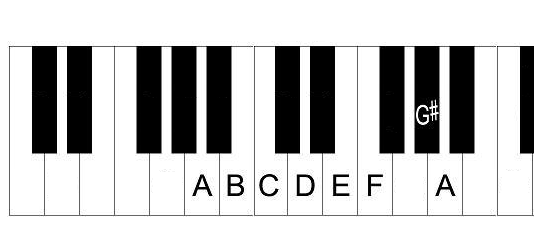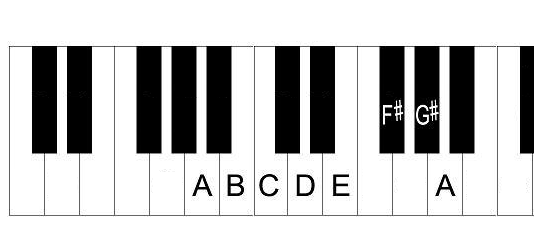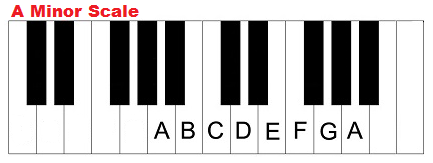This lesson is all about the A minor scale. There are three types of minor scales and we shall take a look at all of them here. They are the natural, melodic and harmonic minor scales.
A Natural Minor Scale
Let’s start with the A natural minor scale. This scale consists of the pitches, A, B, C, D, E, F and G. It has no sharp or flat notes.
Note Intervals
- Tonic: A is the 1st note of the A natural minor scale.
- Major 2nd: B is the 2nd note of the scale.
- Minor 3rd: C is the 3rd note of the scale.
- Perfect 4th: D is the 4th note of the scale.
- Perfect 5th: E is the 5th note of the scale.
- Minor 6th: F is the 6th note of the scale.
- Minor 7th: G is the 7th note of the scale.
- Perfect 8th: A (one octave higher) is the 8th note of the A natural minor scale.
My #1 Recommendation: Go here to learn about the BEST piano/keyboard course I’ve seen online.
Here’s the A minor scale on the treble clef.
Here’s the A minor scale on the bass clef. 
Scale Degrees of Am Scale:
- Tonic: A
- Supertonic: B
- Mediant: C
- Subdominant: D
- Dominant: E
- Submediant: F
- Subtonic: G
- Octave: A
The relative major key for the key of A minor is C major. A natural minor scale/key consists of the same notes as its relative major. The notes of the C major scale are C, D, E, F, G, A and B. As we’ve seen, the A natural minor uses these same notes, except that the sixth note of the major scale becomes the root note of its relative minor.
The formula for forming a natural (or pure) minor scale is W-H-W-W-H-W-W. “W” stands for whole step and “H” stands for half step. To build an A natural minor scale, starting on A, we take a whole step to B. Next, we take a half step to C. From C, a whole step takes us to D. Another whole step takes us to E. From E, we go up a half step to F. From F, we take a whole step to G. Lastly, one more whole step returns us to A, one octave higher.
Fingerings of the A Minor Scale on Piano
What are the fingerings for the A minor scale? They are as follows:
- Notes: A, B, C, D, E, F, G, A
- Fingerings (Left Hand): 5, 4, 3, 2, 1, 3, 2, 1
- Fingerings (Right Hand): 1, 2, 3, 1, 2, 3, 4, 5
Thumb: 1, index finger: 2, middle finger: 3, ring finger: 4 and pinky finger: 5.
Video: How to Play the A Minor Scale
Chords In The Key of A Minor
Let’s now take a look at the chords in the key of A minor.
- Chord i: A minor. Its notes are A – C – E.
- Chord ii: B diminished. Its notes are B – D – F.
- Chord III: C major. Its notes are C – E – G.
- Chord iv: D minor. Its notes are D – F – A.
- Chord v: E minor. Its notes are E – G – B.
- Chord VI: F major. Its notes are F – A – C.
- Chord VII: G major. Its notes are G – B – D.
What are the chords in the key of A minor natural? All about the key of Am and its chords.
Video: Chords in the Key of A Minor
A Harmonic Minor Scale
Let’s now take a look at the A harmonic minor scale.
To play a harmonic minor scale, you simply raise the seventh note of the natural minor scale by a half-step as you go up and down the scale. For example:
Natural A Minor Scale = A – B – C – D – E – F – G – A
Harmonic A Minor Scale = A – B – C – D – E – F – G# – A
The formula for forming a harmonic minor scale is W-H-W-W-H-W 1/2-H. (Whole step – half step – whole step – whole step – half step – whole step and a 1/2 step – half step.)
Harmonic Minor Scale Intervals
- Tonic: The 1st note of the A harmonic minor scale is A.
- Major 2nd: The 2nd note of the scale is B.
- Minor 3rd: The 3rd note of the scale is C.
- Perfect 4th: The 4th note of the scale is D.
- Perfect 5th: The 5th is E.
- Minor 6th: The 6th note is F.
- Major 7th: The 7th note is G#.
- Perfect 8th: The 8th note is A.
Here’s a diagram of the A harmonic minor scale on piano.

Here’s the A minor scale (harmonic) on the treble clef.
Here’s the A minor scale (harmonic) on the bass clef.
A Melodic Minor Scale
For the melodic minor scale, you raise the sixth and seventh notes of the natural minor scale by a half step as you go up the scale and then return to the natural minor as you go down the scale. The notes of the A melodic minor scale ascending are: A – B – C – D – E – F# – G# – A. The notes of the A melodic minor scale descending are: A – B – C – D – E – F – G – A (A natural minor scale).
The formula for a melodic minor scale is whole step – half step – whole step – whole step – whole step – whole step – half step. (W-H-W-W-W-W-H). The descending formula is the natural minor scale formula backwards.
A Melodic Minor Scale Intervals:
- Tonic: The 1st note of the A melodic minor scale is A.
- Major 2nd: The 2nd note of the scale is B.
- Minor 3rd: The 3rd note of the scale is C.
- Perfect 4th: The 4th note of the scale is D.
- Perfect 5th: The 5th note of the scale is E.
- Major 6th: The 6th note of the scale is F#.
- Major 7th: The 7th note of the scale is G#.
- Perfect 8th: The 8th note of the scale is A.
Here’s a diagram of the A melodic minor scale on piano (ascending).

Here’s the scale on the treble clef (ascending).
Here’s the scale on the bass clef (ascending).
Remember that for the melodic minor scale, when descending, you play the natural minor scale.
- Learn how to form other types of scales in all keys.
- Learn how to form major and minor scales in all keys.
- Learn how to play piano and keyboard with Piano For All.
